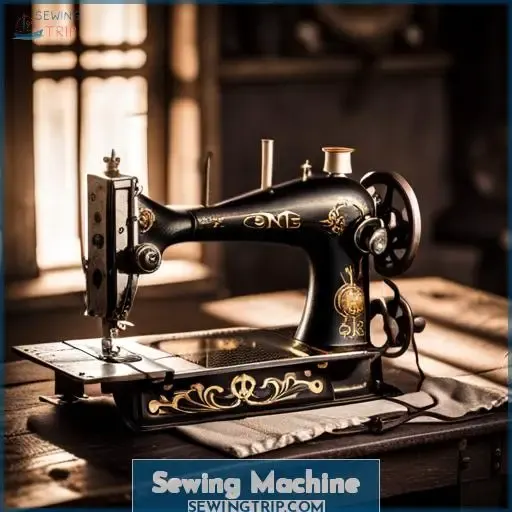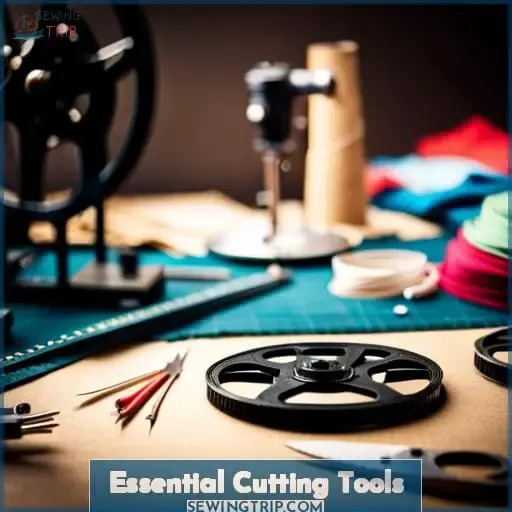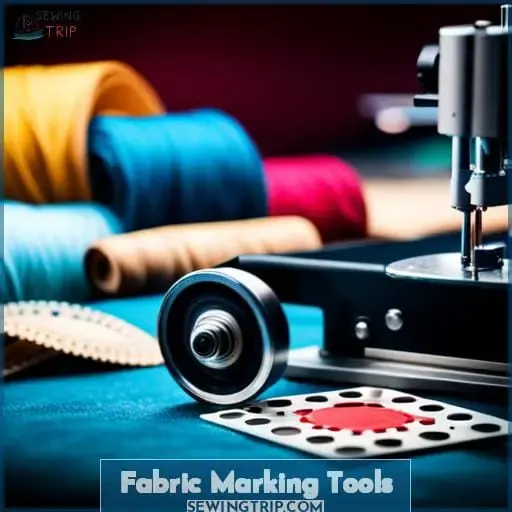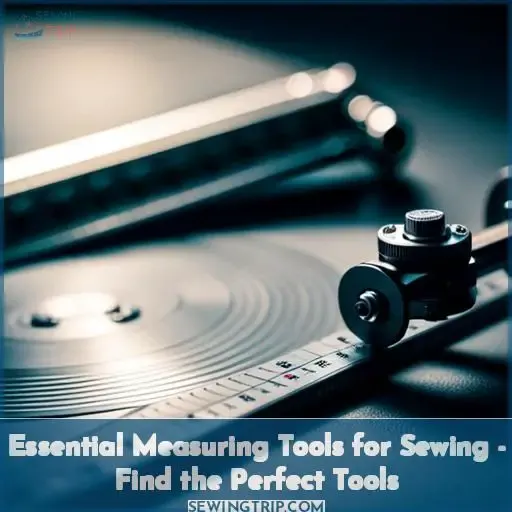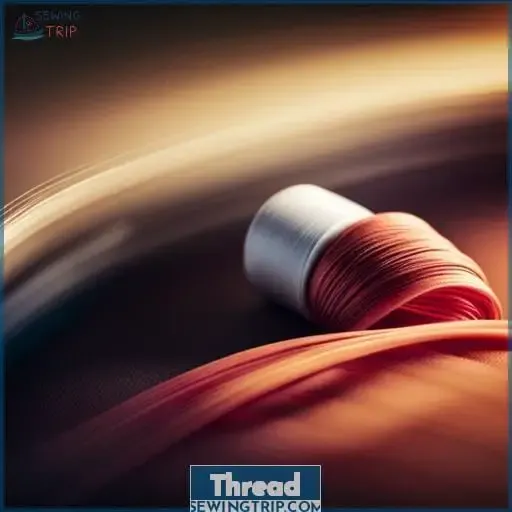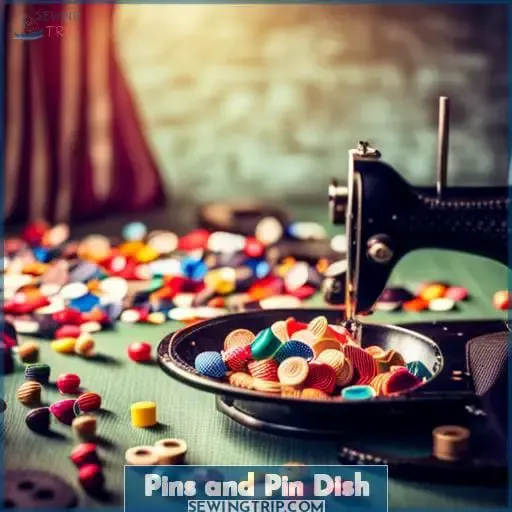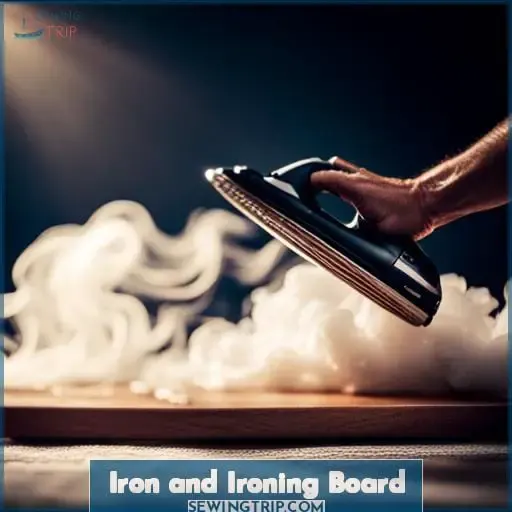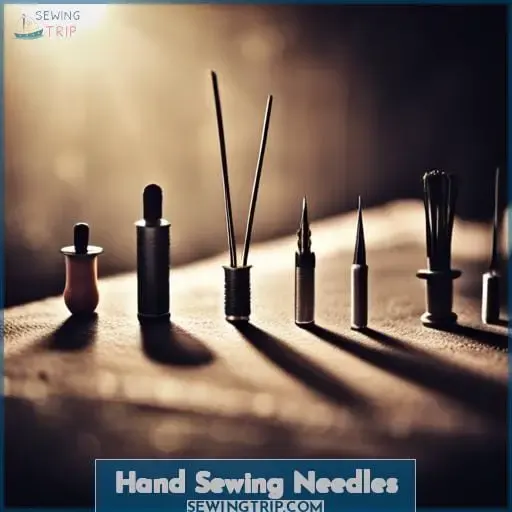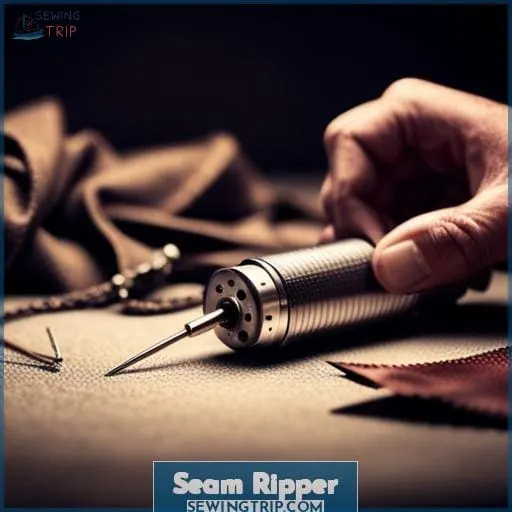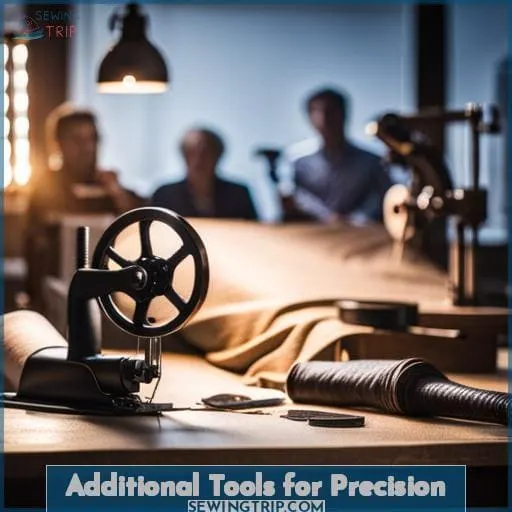This site is supported by our readers. We may earn a commission, at no cost to you, if you purchase through links.
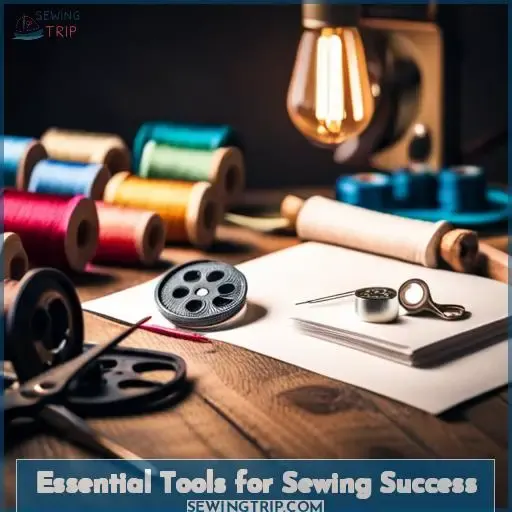 Are you ready to start sewing? Then it’s time to get the essential tools for success! Sewing is a craft that can open up amazing possibilities, allowing you to express yourself through fabric and give life to your creative ideas.
Are you ready to start sewing? Then it’s time to get the essential tools for success! Sewing is a craft that can open up amazing possibilities, allowing you to express yourself through fabric and give life to your creative ideas.
To ensure those projects come together as planned, there are certain items every sewer needs in their toolbox. From scissors and measuring tape to thread and pins – these must-have supplies will make sure that your sewing journey starts off on the right foot.
So what do you need when starting out with sewing? Here’s a comprehensive list of essential equipment so sewers of all levels have everything they need for success!
Table Of Contents
Key Takeaways
- A quality sewing machine with auto-threaders and adjustable presser feet.
- Cutting and measuring tools such as fabric scissors, a plastic cutting board with rulers, and a long measuring tape.
- Marking tools like fabric markers and a selection of thread colors for different fabrics.
- Pressing and finishing tools including an iron and ironing board, hand sewing needles, and a seam ripper.
Sewing Machine
You’ll want to invest wisely in a quality sewing machine that can handle various fabrics, like denim or delicate silks, for all your project needs. As you embark on your sewing journey, a sturdy sewing machine will be your most essential tool.
Do some research to find reliable brands known for longevity, even stitch quality, and user-friendly features like auto-threaders or adjustable presser feet.
Look for models with settings for multiple fabrics, a free arm, and plenty of accessories. Don’t skimp on your machine – this investment’s well worth it and will last for years. Take time to get familiar with all the features and capabilities. Refer to your manual to properly maintain and troubleshoot issues to keep it running smoothly.
With the right sewing machine, you’ll have the creative freedom to bring any fabric vision to life. Your machine will quickly become your trusty sidekick in crafting wearable art and home goods galore.
Essential Cutting Tools
To get your cutting skills off the ground, three essential tools are key. You’ll need quality fabric scissors specifically for cutting fabric, a cutting board with rulers for precise cuts, and backup machine needles on hand for when your main needle gets dull.
Having these fundamental cutting tools ready ensures you can cut fabric cleanly and precisely as you start any sewing project.
Scissors
High-quality fabric shears perfectly tailored for fabric are vital for clean cuts. Invest in sharp, high-quality fabric scissors designed specifically for cutting fabric. Choose from brands like Gingher or Kai for precision. Maintain blades by avoiding paper cutting and getting them sharpened regularly.
Store properly to prevent nicks. For longevity, never use them on anything but fabric. With quality shears, you’ll achieve the clean, precise cuts that lead to professional results.
Cutting Board
For accurate cuts, a plastic board marked with rulers is essential. Buying the right sized cutting mat for your space allows ample room for layouts. Use large sizes for quilting, smaller for garments. Self-healing mats are ideal, absorbing cuts while protecting surfaces.
Invest in a quality mat – flimsy boards lead to slipping. Maintain it by wiping clean after projects. With the proper care, a quality cutting mat will serve you for years of precise cutting.
Extra Sewing Machine Needles
Always keep backup needles in your kit, like soldiers ready for battle against torn fabric. Choose needles for your project’s fabric type – universal for wovens, stretch for knits, denim for jeans. Change needles often to avoid skipped stitches and snags. Follow size guidelines – thinner for lightweight, thicker for heavy fabrics.
Stock quality brands like Schmetz or Organ. If you see skipped stitches, breakage, or snags, swap in a fresh needle before troubleshooting other issues.
Fabric Marking Tools
Fabric marking tools are an essential part of your sewing kit. These tools will allow you to transform paper patterns into accurate markings on fabric. I recommend starting with a pack of water-soluble fabric markers. The ink will vanish completely after washing, preventing any stray marks from marring your finished project.
You’ll also want to grab an air-soluble marker. They’re perfect for transferring any vertical markings, as gravity helps the ink dissipate. Round out your kit with a tracing wheel and tracing paper for timeless garment construction.
Always test markers on a fabric scrap first. Make sure the marks disappear after laundering. With the right tools, you’ll transfer intricate designs with confidence and ease. Your projects will progress smoothly from pattern to permanently stitched creation.
Measuring Tools
You’ll want an accurate measuring tape for taking precise measurements when sewing your own clothes. For example, carefully measuring your bust, waist, and hip circumference ensures you cut out the right pattern size for a perfect fit.
Here are some helpful measuring tools for beginners:
| Tool | Use | Tips |
|---|---|---|
| Measuring Tape | Taking body measurements for pattern sizing | Get a long, flexible tape that won’t stretch or warp |
| Dressmaking Scissors | Precise cutting of woven fabrics | Invest in a high-quality pair for clean cuts |
| Rotary Cutter | Curved cuts and quilting | Use with a self-healing mat to protect surfaces |
Measuring accurately is crucial for achieving a well-fitting garment and may require some practice. Don’t pull the tape too tight or loose. Record a few test measurements to check consistency.
Make any needed pattern adjustments based on your personalized measurements. With the right tools and techniques, you’ll be measuring like a pro in no time.
Thread
As any sewing instructor will tell you, quality thread is essential for successful sewing projects. Choosing the right thread prevents a multitude of issues down the line. First, consider thread types.
While all-purpose polyester is suitable for most fabrics, cotton thread has more give for knits and woven fabrics. Silk thread is best for finer fabrics. For denim, jeans, and heavy upholstery, use extra-strong polyester.
Explore color options too. Match thread to fabric color when possible or go a shade darker. Keep a range of versatile neutrals like white, black, gray on hand, plus colors to coordinate projects.
Don’t skimp on thread quality. Cheap thread can pill, shred, or break and damage fabric.
Proper thread storage extends longevity. Keep spools in low humidity in an airtight case.
Finally, consistent thread tension prevents pesky problems like puckering and looping. With quality tools and materials in your sewing kit, you’re on the path to sewing success.
Pins and Pin Dish
Keep handy a magnetic pin dish and pins – that’ll save your sanity when prepping fabric. Select sturdy pins that won’t bend or break when pinning thicker fabrics. Choose pins with large, easy-to-grasp heads.
Invest in a magnetic pin dish to keep pins from scattering everywhere. Dish styles include simple round trays, rectangular magnetic boards, fabric pin cushions, or wall-mounted magnetic bars.
Store the dish on your sewing table or mount it on the wall within reach. Never leave stray pins in your workspace – they’re a puncture hazard! With a quality magnetic pin holder nearby, managing pins is a cinch.
Iron and Ironing Board
Iron properly sewn seams so they lie flat! An iron is essential for pressing fabric, seams, and hems on your sewing projects. Set up your ironing board near an electrical outlet at a comfortable height. Make sure your iron’s water reservoir is filled, and start by ironing a scrap piece of fabric to ensure proper heat settings for the particular fabric you’re working with.
Always remember basic iron safety – don’t leave an iron unattended or within reach of children or pets, and place it on its heel or heat-resistant surface when not in use. Practice good ironing techniques like pressing along the grain line and lifting the iron as you move it rather than pushing and dragging.
Here’s a quick reference for recommended iron settings by fabric:
| Fabric | Heat Setting |
|---|---|
| Silk | Low |
| Wool | Low to medium |
| Cotton | Medium to high |
| Linen | High |
With a well-maintained iron and ironing board, you’ll be pressing your sewing projects to perfection in no time!
Hand Sewing Needles
You’d be surprised to learn that roughly half of sewists still use hand sewing needles regularly for finishing touches, according to a 2019 poll.
Hand sewing may seem old-fashioned, but it has its place in modern sewing. Choosing the right needle for your project is key. Consider needle types like sharps for general hand sewing or embroidery needles for decorative touches.
Needle sizes matter too – a thicker needle for denim or thinner for lightweight fabric.
Popular brands include Dritz, John James, and Bohin. Carefully thread your needle, knotting the end of the thread. Try needle threaders for tricky threading. Store hand needles neatly in a vintage needle book, magnetic pincushion, or thread cases to keep them from getting lost.
While hand sewing requires practice, a basic straight stitch can add discreet, invisible details to your makes. With so many options, it’s worth keeping an assortment of hand sewing needles in your essential sewing kit.
Seam Ripper
Bout time you grabbed a seam ripper for fixin’ mistakes along the way. That lil’ tool’s your new best friend when you make a boo-boo. Just don’t go rippin’ recklessly, let her glide gently along the thread. Let the ripper do the work, don’t force or tug.
Once you get in a groove, mistakes happen less. But keep a fresh ripper handy for tricky projects. Dull blades tear fabric. So keep yours sharp by pullin’ it across denim now and then.
Every stitcher needs patchin’ up once in a while. Oh, and don’t despair about unpickin’ stitches. It’s part of the process. No shame in startin’ over to get things just right. Fix, learn, and carry on with pride.
Additional Tools for Precision
Gathering the right tools will help ensure your sewing projects turn out precise. Invest in a flexible tape measure, paper scissors, and tracing tools like colored pens, tracing paper, a tracing wheel, and rulers or a French curve to perfectly transfer pattern markings onto fabric.
Flexible Tape Measure
For precise measurements, use a flexible tape measure to obtain your body dimensions when sizing patterns.
- Wrap snugly around the fullest part of the bust, waist, and hips.
- To measure length, measure from the shoulder to the desired hem length.
- Note the garment ease needed.
- Record all measurements for quick reference.
With proper technique, a flexible tape measure enables accurate body measurements for suitable pattern sizing.
Paper Scissors
You’ll tote shaped paper cutters for tidily hewing pattern pieces. For sewing beginners, choose paper scissors specifically for clipping pattern templates. Unlike fabric shears, paper scissors boast smaller, pointed tips. Maintain their sharpness by honing paper shears only on sandpaper.
Tracing Tools (Optional)
Though they are not absolutely necessary, you can purchase tracing tools like colored pens, tracing paper, a tracing wheel, rulers, and a French curve to precisely transfer pattern markings. With tools like tracing wheels, you can use tailor’s tacks or carbon tracing paper for flawless pattern transfers.
A curve ruler aids in marking darts and seam lines smoothly. Colored tracing pens allow you to customize your markings. While not required, these tools empower precise pattern tracing for your custom creations.
Frequently Asked Questions (FAQs)
What sewing machine feet are essential? The article lists a sewing machine as essential but doesn’t mention machine feet. Beginners may ask what presser feet they need.
Most sewing machines come with a basic foot or two, but you’ll want more for specialized techniques. At a minimum, get a zipper foot and buttonhole foot. A walking foot helps feed thicker fabrics evenly.
Conclusion
It’s time to start sewing like a pro! With the right sewing machine, essential cutting tools, fabric marking tools, measuring tools, thread, pins and a pin dish, an iron and ironing board, hand sewing needles, and a seam ripper, you’ll be ready to tackle any sewing project with ease.
Don’t forget to add precision tools like a flexible tape measure, paper scissors, tracing tools, and other specialized tools to your kit for even better results.

